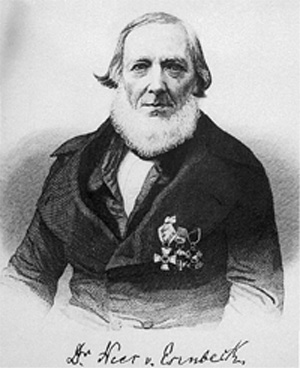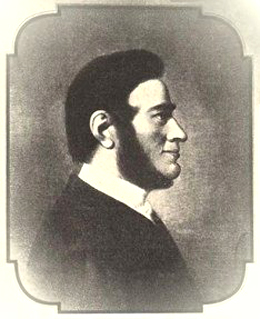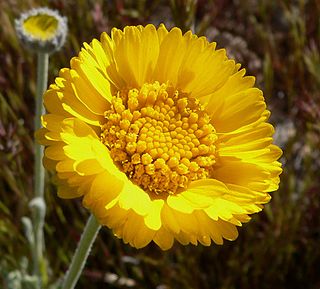Dinosaurus is an extinct genus of therapsid of controversial affinities. Its type and only species is Dinosaurus murchisonii. It is only known from a partial snout from the Permian of Russia. Its taxonomic history is intertwined with several other poorly-known Russian therapsids, particularly Rhopalodon, Brithopus, and Phthinosuchus.
In biology, a monotypic taxon is a taxonomic group (taxon) that contains only one immediately subordinate taxon. A monotypic species is one that does not include subspecies or smaller, infraspecific taxa. In the case of genera, the term "unispecific" or "monospecific" is sometimes preferred. In botanical nomenclature, a monotypic genus is a genus in the special case where a genus and a single species are simultaneously described. In contrast, an oligotypic taxon contains more than one but only a very few subordinate taxa.

Cymbidium, commonly known as boat orchids, is a genus of evergreen flowering plants in the orchid family Orchidaceae. Orchids in this genus are epiphytic, lithophytic, terrestrial or rarely leafless saprophytic herbs usually with pseudobulbs. There are usually between three and twelve leaves arranged in two ranks on each pseudobulb or shoot and lasting for several years. From one to a large number of flowers are arranged on an unbranched flowering stem arising from the base of the pseudobulb. The sepals and petals are all free from and similar to each other. The labellum is significantly different from the other petals and the sepals and has three lobes. There are about fifty-five species and sixteen further natural hybrids occurring in the wild from tropical and subtropical Asia to Australia. Cymbidiums are well known in horticulture and many cultivars have been developed.

Christian Gottfried Daniel Nees von Esenbeck was a prolific German botanist, physician, zoologist, and natural philosopher. He was a contemporary of Goethe and was born within the lifetime of Linnaeus. He described approximately 7,000 plant species. His last official act as president of the German Academy of Natural Scientists Leopoldina was to admit Charles Darwin as a member. He was the author of numerous monographs on botany and zoology. His best-known works deal with fungi.

Carl Borivoj Presl was a Czech botanist.

A botanical name is a formal scientific name conforming to the International Code of Nomenclature for algae, fungi, and plants (ICN) and, if it concerns a plant cultigen, the additional cultivar or Group epithets must conform to the International Code of Nomenclature for Cultivated Plants (ICNCP). The code of nomenclature covers "all organisms traditionally treated as algae, fungi, or plants, whether fossil or non-fossil, including blue-green algae (Cyanobacteria), chytrids, oomycetes, slime moulds and photosynthetic protists with their taxonomically related non-photosynthetic groups ."

Hieronyma is a genus in the plant family Phyllanthaceae. It was first described as a genus in 1848. This family was formerly united with spurges, crotons, copperleaves, etc. (Euphorbiaceae), but have turned out to be well distinct. The genus is native to South America, Central America, southern Mexico, and the West Indies. It is dioecious, with male and female flowers on separate plants.

Baileya is a genus of plants in the aster family Asteraceae. All are native to the southwestern United States and to Mexico.
Otto Eugen Schulz was a German botanist, born in Berlin. He was the brother of botanist Roman Schulz (1873–1926).
Wilhelm Gerhard Walpers was a German botanist. This botanist is denoted by the author abbreviation Walp. when citing a botanical name.
Johannes Conrad Schauer was a botanist interested in spermatophytes. He was born in Frankfurt am Main and attended the gymnasium of Mainz from 1825 to 1837. For the next three years he worked at the Hofgarten of Würzburg. Schauer then gained a position as assistant at the botanical garden at Bonn where he worked until 1832 when he was placed in charge of the botanic garden in Breslau, with C.G. Nees. He gained the degree of Doctor of Philosophy at the University of Erlangen-Nuremberg 1835 and was appointed professor of botany at the University of Greifswald from 1843 until his death in 1848.
Siegfried Reissek was an Austrian naturalist and botanist who specialized in spermatophytes. He is known for his studies involving plant anatomy and histology.

Drosera subg. Ergaleium, collectively known as the tuberous sundews, is a subgenus of three sections of tuberous species in the genus Drosera. The three sections represent natural groups, including the rosetted species, the fan-leaved species, and the erect or scrambling species.

Drosera subg. Lasiocephala, sometimes collectively known as the petiolaris-complex, is a subgenus of 14 species in the genus Drosera. These species are distinguished by their subpeltate to peltate lamina.
Edward George Irving (1816–1855) was a Scottish surgeon who served in the Royal Navy. He was also a collector of plants, and the plant family Irvingiaceae, and genus Irvingia are named after him.

In botany, a whorl or verticil is a whorled arrangement of leaves, sepals, petals, stamens, or carpels that radiate from a single point and surround or wrap around the stem or stalk. A leaf whorl consists of at least three elements; a pair of opposite leaves is not called a whorl.

Thomas Huston Macbride was the tenth president of the University of Iowa, serving from 1914 to 1916. Macbride was a naturalist and botanist, Macbride Hall at the University of Iowa is named for him. He often collaborated with Samuel Calvin. He was the 75th member of the Acacia chapter at the University of Iowa.
Vittore Benedetto Antonio Trevisan de Saint-Léon was an Italian botanist who specialized in cryptogamic flora.
Campylostachys is a genus of flowering plants in the family Stilbaceae described as a genus in 1832.
Johann Adam Philipp Hepp was a German physician and lichenologist.









